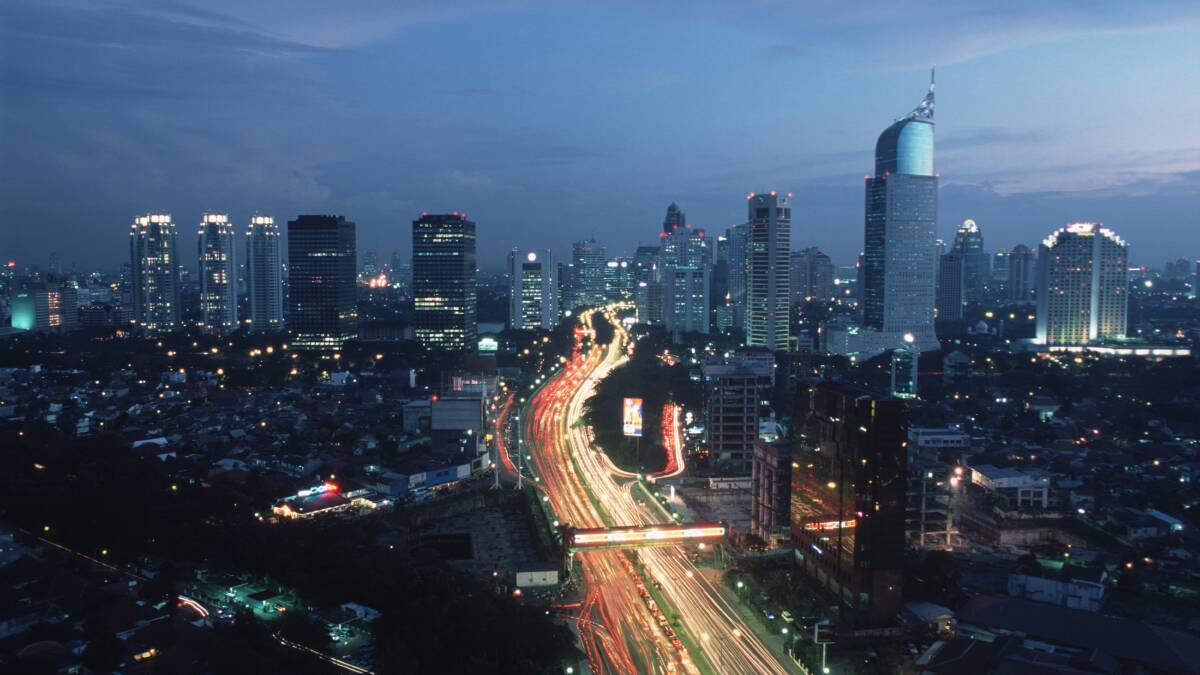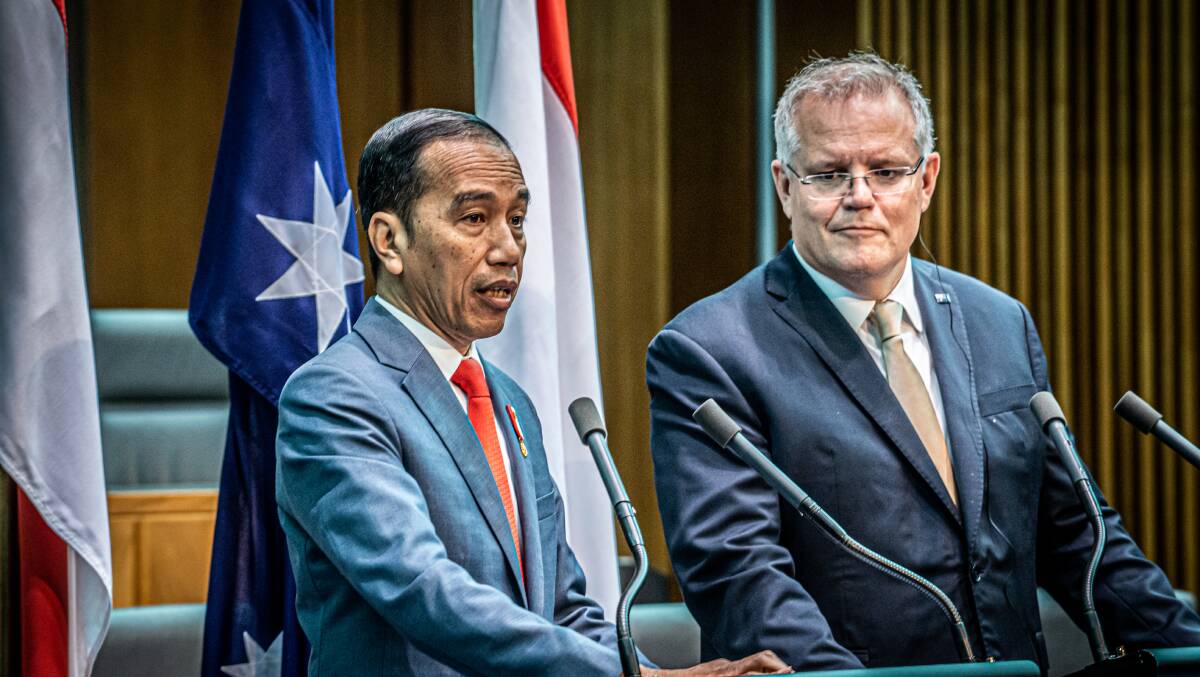Indonesian President Joko Widodo addressed the Australian Parliament on Monday - the first such event since his predecessor, Susilo Bambang Yudhoyono, did so a decade ago. The address celebrated the passing of the long-awaited Indonesia-Australia Comprehensive Economic Partnership Agreement as well as 70 years of diplomatic relations between the two countries.
Subscribe now for unlimited access.
or signup to continue reading

For President Widodo, though, a visit to Canberra comes with another motive - with plans to construct a purpose-built new capital for Indonesia already under way.
Breakdowns in the Australia-Indonesia relationship over the first two decades of this century have been well-documented. Spy scandals, the Bali Nine executions and anti-Muslim rhetoric have largely been smoothed over by expert diplomacy on both sides. Hiccups are a feature of the relationship and will happen again.
Navigating those hiccups is never the prerogative of Canberra itself, although our city will be the shorthand for it. But we now have a new opportunity to deepen real links with Indonesia, beginning atop Mount Ainslie and ending in East Kalimantan, a province on the island of Borneo.
President Widodo took in the sights from Canberra's mountain to learn how a planned capital can look. He inspected the Burley Griffin "Y-plan" alongside representatives from the National Capital Authority and Governor-General David Hurley.
"I asked the governor a lot of questions, as well as Australian Prime Minister Scott Morrison and National Capital Authority CEO Sally Barnes - we want to have a complete picture of what it takes to develop Canberra, how to [construct a capital] from scratch," the President said in a statement issued by the palace in Jakarta.

Canberra couldn't look much more different from Jakarta if it tried. The population of Indonesia's current capital is, depending on which metric one uses, either between 10 and 13 million or, if satellite cities are taken into account, 30 million.
North Jakarta skirts the Java Sea, and is expected to be fully submerged by 2050. Congestion causes poor air quality - think Canberra's smoky summer, but daily - and makes it difficult for the hundreds of parliamentary representatives and thousands of public servants to move around.
Moving the capital isn't a new idea - it was floated by the country's first president, Sukarno, back in the 1960s. Each of his successors has flirted with the idea, so much so that when President Jokowi announced his intentions after winning his second and final term last year it was met with incredulity by most Jakartans.
The plan he will take to the Indonesian parliament could look a lot like Canberra. Widodo pointed to the city's spatial planning from Mount Ainslie, noting that buildings within the administrative sections of Canberra are typically no more than seven or so storeys tall, while within the social centres they grow much larger.
The President has a clear concept for his new capital. He wants it to be a "smart city", one which is interconnected and understands the needs of its occupants. He wants it to be green, with access to public transport that works for both users and the environment. Canberra is not just a Y-plan, we're also this city.
READ MORE:
Widodo has inspiration close by. Malaysia moved its capital from Kuala Lumpur to the purpose-built Putrajaya in 1999, citing similar sprawl and congestion concerns to Jakarta. Myanmar also constructed Naypyidaw in 2005 to move the capital from Yangon, although the motivation for that was more convoluted and included the possible influence of black magic over the military junta.
Canberra has something neither of those two cities yet have. After a century, Canberra has developed its own sense of identity, culture and community. For a rising Indonesia set to join the ranks of the world's largest economies and of increasingly important strategic might, a capital that reflects the country's culture to the world is far more preferable than one which is simply the part-time home of FIFO lawmakers.
Canberra can serve as a road map not just for efficient city-planning, but for building community.
Already we play host to some of Indonesia's best and brightest students and academics at our universities and think tanks. Let's formalise that further, with a people-to-people focused sister city arrangement with the as-yet-unnamed new Indonesian capital.
Canberra's history with sister cities is an unfinished project in our city's global future. Beijing was a major win for the Carnell government, which inked a sister city arrangement all the way back in 2000. In the two decades since, Beijing has become one of our busiest sisters, but still affords us some meaningful bonding time - like when we were the only Australian city or town to host the torch relay ahead of the Olympic Games in 2008.
Wellington, the New Zealand capital fittingly overshadowed by the louder Auckland, formalised a sister city agreement with Canberra in 2016. Both sides of the Tasman were blunt about the arrangement at the time. A new Singapore Air link between the capitals on the way to the city-state was an occasion worth celebrating with a formal arrangement of sisterhood.
Nara, Japan, is Canberra's oldest sister city, reaching its agreement back in 1993. Unlike the other two newer sisters, the agreement with Nara was motivated primarily by people-to-people links and advocated for by Father Tony Glynn, who was stationed in the city during World War II. Now, according to the ACT government, that relationship is more about learning and cultural exchanges than the strategic and economic motivations behind the agreement with Beijing.
Any arrangement between the new Indonesian capital and Canberra should be a blend of these three existing arrangements. Not strictly strategic focused, but also not just a matter of the coincidence of geography - with a focus on people-to-people community building.
The "Canberra bubble" is preoccupied with courting Indonesia and ensuring Australia maintains relations with its giant neighbour. Outside that bubble, in the real Canberra, we have a unique opportunity to truly get to know those across the fence. Let's seize it by becoming the new city's first capital sister.
- Erin Cook is a journalist based in south-east Asia where she runs the darimulut.substack.com weekly newsletter and co-hosts the Indonesia Dan Lain-Lain podcast.

